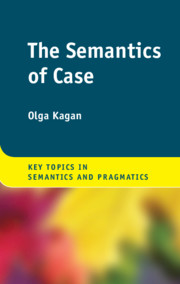Refine search
Actions for selected content:
6584 results in Grammar and Syntax
7 - Predicate Case
-
- Book:
- The Semantics of Case
- Published online:
- 02 April 2020
- Print publication:
- 16 April 2020, pp 223-250
-
- Chapter
- Export citation
Acknowledgments
-
- Book:
- The Semantics of Case
- Published online:
- 02 April 2020
- Print publication:
- 16 April 2020, pp xi-xiii
-
- Chapter
- Export citation
Contents
-
- Book:
- The Semantics of Case
- Published online:
- 02 April 2020
- Print publication:
- 16 April 2020, pp vii-viii
-
- Chapter
- Export citation
4 - Case and Aspect
-
- Book:
- The Semantics of Case
- Published online:
- 02 April 2020
- Print publication:
- 16 April 2020, pp 99-146
-
- Chapter
- Export citation
8 - Generalizations and Conclusions
-
- Book:
- The Semantics of Case
- Published online:
- 02 April 2020
- Print publication:
- 16 April 2020, pp 251-256
-
- Chapter
- Export citation

The Semantics of Case
-
- Published online:
- 02 April 2020
- Print publication:
- 16 April 2020

World Lexicon of Grammaticalization
-
- Published online:
- 12 February 2020
- Print publication:
- 08 August 2019
1 - Introduction: Word Categories and Category Mixing
-
- Book:
- Mixed Categories
- Published online:
- 28 October 2019
- Print publication:
- 31 October 2019, pp 1-39
-
- Chapter
- Export citation
Language Index
-
- Book:
- Mixed Categories
- Published online:
- 28 October 2019
- Print publication:
- 31 October 2019, pp 380-382
-
- Chapter
- Export citation
Other books in the series
-
- Book:
- Mixed Categories
- Published online:
- 28 October 2019
- Print publication:
- 31 October 2019, pp 397-398
-
- Chapter
- Export citation
Preface
-
- Book:
- Mixed Categories
- Published online:
- 28 October 2019
- Print publication:
- 31 October 2019, pp xv-xvi
-
- Chapter
- Export citation
Contents
-
- Book:
- Mixed Categories
- Published online:
- 28 October 2019
- Print publication:
- 31 October 2019, pp vii-x
-
- Chapter
- Export citation
4 - Approaches to Mixed Categories
-
- Book:
- Mixed Categories
- Published online:
- 28 October 2019
- Print publication:
- 31 October 2019, pp 126-170
-
- Chapter
- Export citation
Frontmatter
-
- Book:
- Mixed Categories
- Published online:
- 28 October 2019
- Print publication:
- 31 October 2019, pp i-vi
-
- Chapter
- Export citation
3 - Categorial Mixing in the Nominal Phrase
-
- Book:
- Mixed Categories
- Published online:
- 28 October 2019
- Print publication:
- 31 October 2019, pp 85-125
-
- Chapter
- Export citation
Author Index
-
- Book:
- Mixed Categories
- Published online:
- 28 October 2019
- Print publication:
- 31 October 2019, pp 383-386
-
- Chapter
- Export citation
9 - Conclusions and Prospects
-
- Book:
- Mixed Categories
- Published online:
- 28 October 2019
- Print publication:
- 31 October 2019, pp 348-355
-
- Chapter
- Export citation
Bibliography
-
- Book:
- Mixed Categories
- Published online:
- 28 October 2019
- Print publication:
- 31 October 2019, pp 356-379
-
- Chapter
- Export citation
7 - Attributive Modification in Lexicalist Morphosyntax
-
- Book:
- Mixed Categories
- Published online:
- 28 October 2019
- Print publication:
- 31 October 2019, pp 239-283
-
- Chapter
- Export citation
6 - Generalized Paradigm Function Morphology
-
- Book:
- Mixed Categories
- Published online:
- 28 October 2019
- Print publication:
- 31 October 2019, pp 204-238
-
- Chapter
- Export citation
